Business Environment Analysis and Management
VerifiedAdded on 2020/10/22
|16
|4838
|319
AI Summary
This assignment requires a detailed analysis of the business environment, including the use of PESTLE (Political, Economic, Social, Technological, Legal, Environmental) analysis to identify external macro factors that impact business operations. Additionally, SWOT (Strengths, Weaknesses, Opportunities, Threats) analysis is applied to examine internal strengths and weaknesses in relation to external factors. The report also references various books, journals, and online resources related to business environment management.
Contribute Materials
Your contribution can guide someone’s learning journey. Share your
documents today.
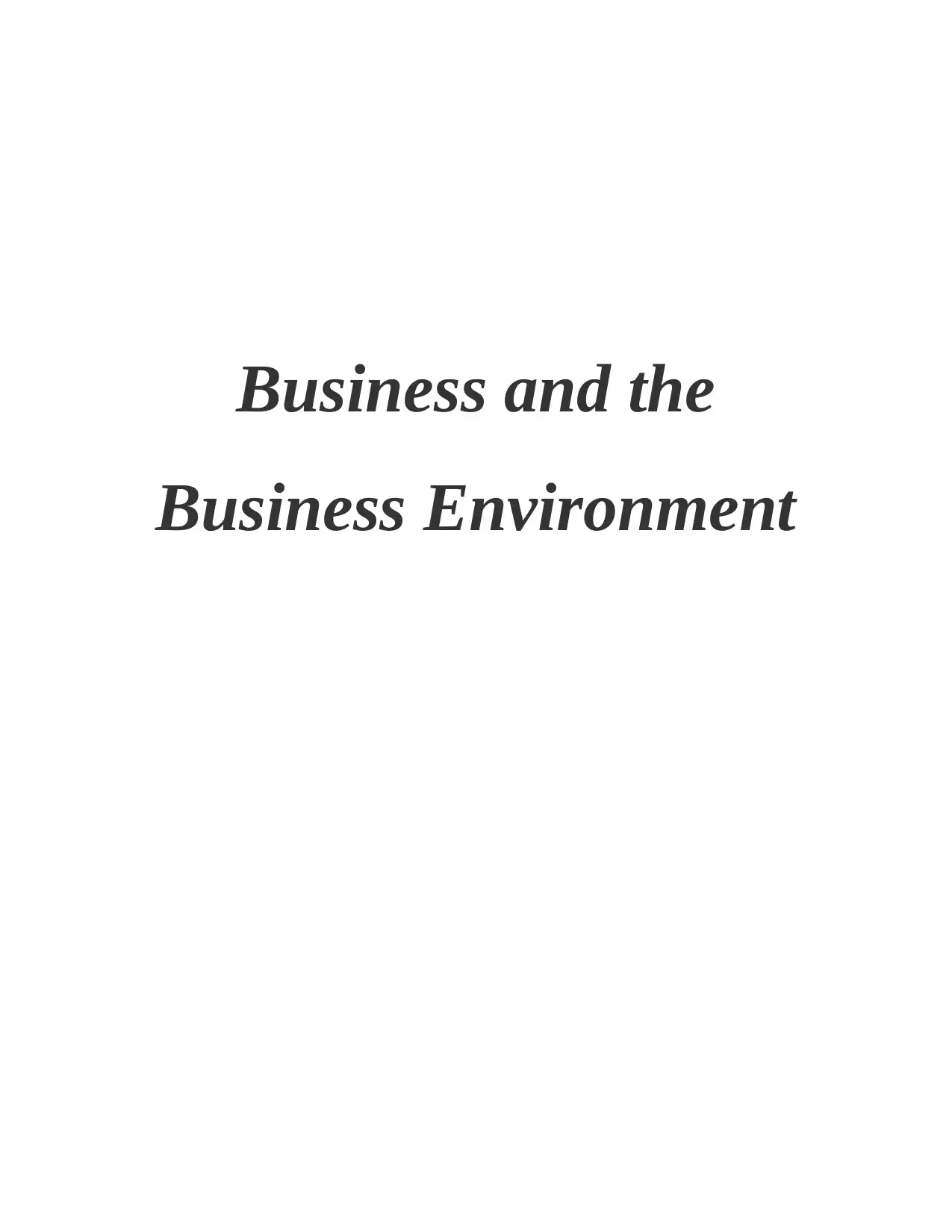
Business and the
Business Environment
Business Environment
Secure Best Marks with AI Grader
Need help grading? Try our AI Grader for instant feedback on your assignments.
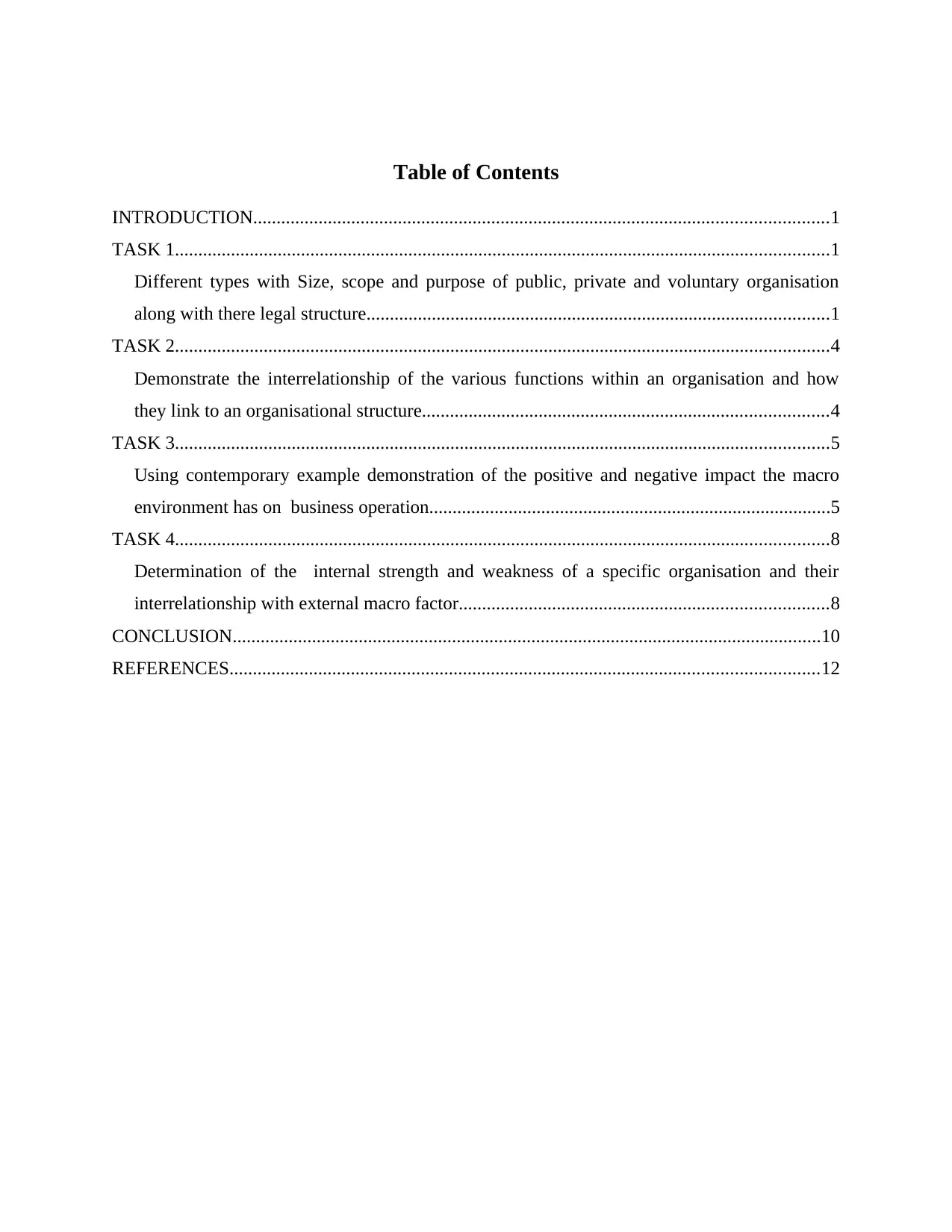
Table of Contents
INTRODUCTION...........................................................................................................................1
TASK 1............................................................................................................................................1
Different types with Size, scope and purpose of public, private and voluntary organisation
along with there legal structure...................................................................................................1
TASK 2............................................................................................................................................4
Demonstrate the interrelationship of the various functions within an organisation and how
they link to an organisational structure.......................................................................................4
TASK 3............................................................................................................................................5
Using contemporary example demonstration of the positive and negative impact the macro
environment has on business operation......................................................................................5
TASK 4............................................................................................................................................8
Determination of the internal strength and weakness of a specific organisation and their
interrelationship with external macro factor...............................................................................8
CONCLUSION..............................................................................................................................10
REFERENCES..............................................................................................................................12
INTRODUCTION...........................................................................................................................1
TASK 1............................................................................................................................................1
Different types with Size, scope and purpose of public, private and voluntary organisation
along with there legal structure...................................................................................................1
TASK 2............................................................................................................................................4
Demonstrate the interrelationship of the various functions within an organisation and how
they link to an organisational structure.......................................................................................4
TASK 3............................................................................................................................................5
Using contemporary example demonstration of the positive and negative impact the macro
environment has on business operation......................................................................................5
TASK 4............................................................................................................................................8
Determination of the internal strength and weakness of a specific organisation and their
interrelationship with external macro factor...............................................................................8
CONCLUSION..............................................................................................................................10
REFERENCES..............................................................................................................................12
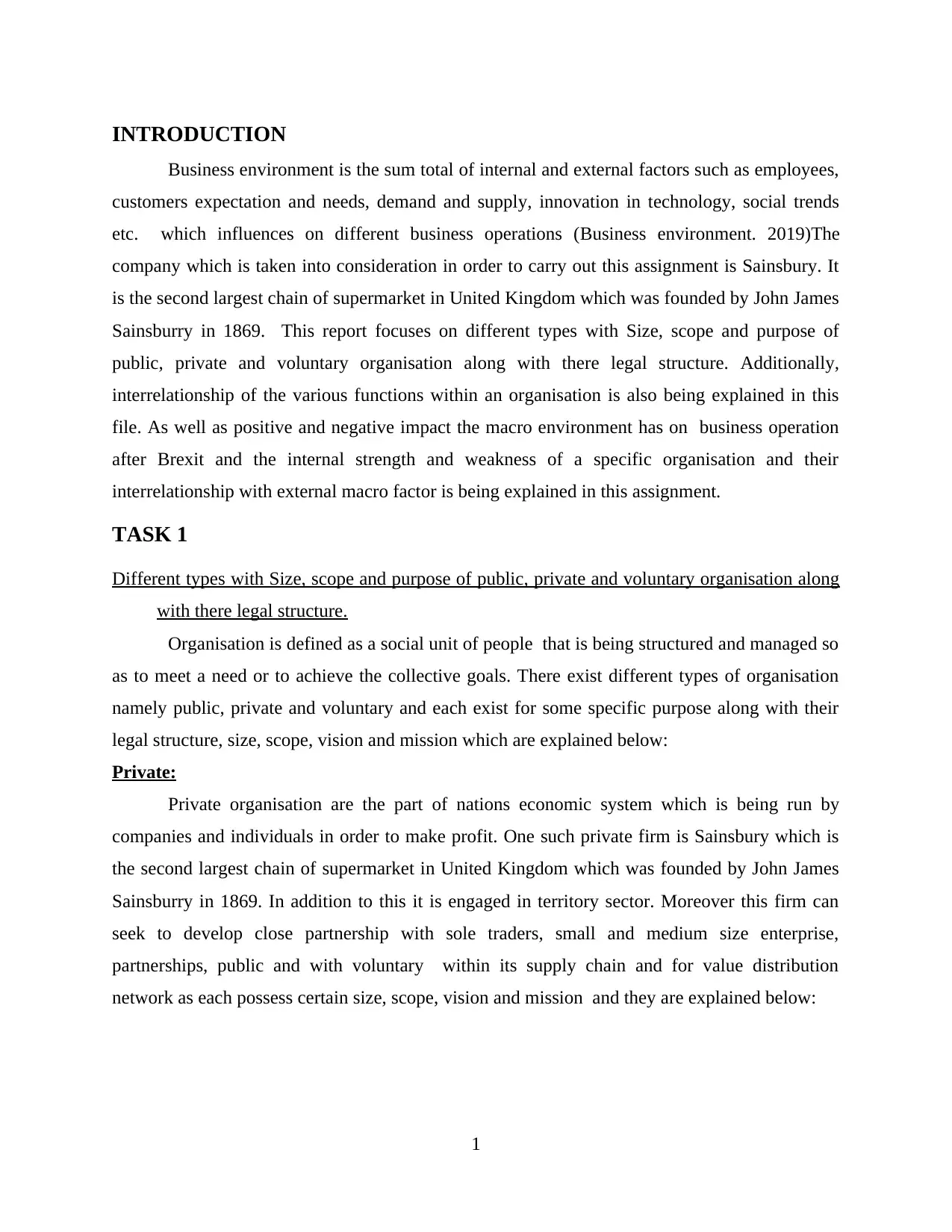
INTRODUCTION
Business environment is the sum total of internal and external factors such as employees,
customers expectation and needs, demand and supply, innovation in technology, social trends
etc. which influences on different business operations (Business environment. 2019)The
company which is taken into consideration in order to carry out this assignment is Sainsbury. It
is the second largest chain of supermarket in United Kingdom which was founded by John James
Sainsburry in 1869. This report focuses on different types with Size, scope and purpose of
public, private and voluntary organisation along with there legal structure. Additionally,
interrelationship of the various functions within an organisation is also being explained in this
file. As well as positive and negative impact the macro environment has on business operation
after Brexit and the internal strength and weakness of a specific organisation and their
interrelationship with external macro factor is being explained in this assignment.
TASK 1
Different types with Size, scope and purpose of public, private and voluntary organisation along
with there legal structure.
Organisation is defined as a social unit of people that is being structured and managed so
as to meet a need or to achieve the collective goals. There exist different types of organisation
namely public, private and voluntary and each exist for some specific purpose along with their
legal structure, size, scope, vision and mission which are explained below:
Private:
Private organisation are the part of nations economic system which is being run by
companies and individuals in order to make profit. One such private firm is Sainsbury which is
the second largest chain of supermarket in United Kingdom which was founded by John James
Sainsburry in 1869. In addition to this it is engaged in territory sector. Moreover this firm can
seek to develop close partnership with sole traders, small and medium size enterprise,
partnerships, public and with voluntary within its supply chain and for value distribution
network as each possess certain size, scope, vision and mission and they are explained below:
1
Business environment is the sum total of internal and external factors such as employees,
customers expectation and needs, demand and supply, innovation in technology, social trends
etc. which influences on different business operations (Business environment. 2019)The
company which is taken into consideration in order to carry out this assignment is Sainsbury. It
is the second largest chain of supermarket in United Kingdom which was founded by John James
Sainsburry in 1869. This report focuses on different types with Size, scope and purpose of
public, private and voluntary organisation along with there legal structure. Additionally,
interrelationship of the various functions within an organisation is also being explained in this
file. As well as positive and negative impact the macro environment has on business operation
after Brexit and the internal strength and weakness of a specific organisation and their
interrelationship with external macro factor is being explained in this assignment.
TASK 1
Different types with Size, scope and purpose of public, private and voluntary organisation along
with there legal structure.
Organisation is defined as a social unit of people that is being structured and managed so
as to meet a need or to achieve the collective goals. There exist different types of organisation
namely public, private and voluntary and each exist for some specific purpose along with their
legal structure, size, scope, vision and mission which are explained below:
Private:
Private organisation are the part of nations economic system which is being run by
companies and individuals in order to make profit. One such private firm is Sainsbury which is
the second largest chain of supermarket in United Kingdom which was founded by John James
Sainsburry in 1869. In addition to this it is engaged in territory sector. Moreover this firm can
seek to develop close partnership with sole traders, small and medium size enterprise,
partnerships, public and with voluntary within its supply chain and for value distribution
network as each possess certain size, scope, vision and mission and they are explained below:
1
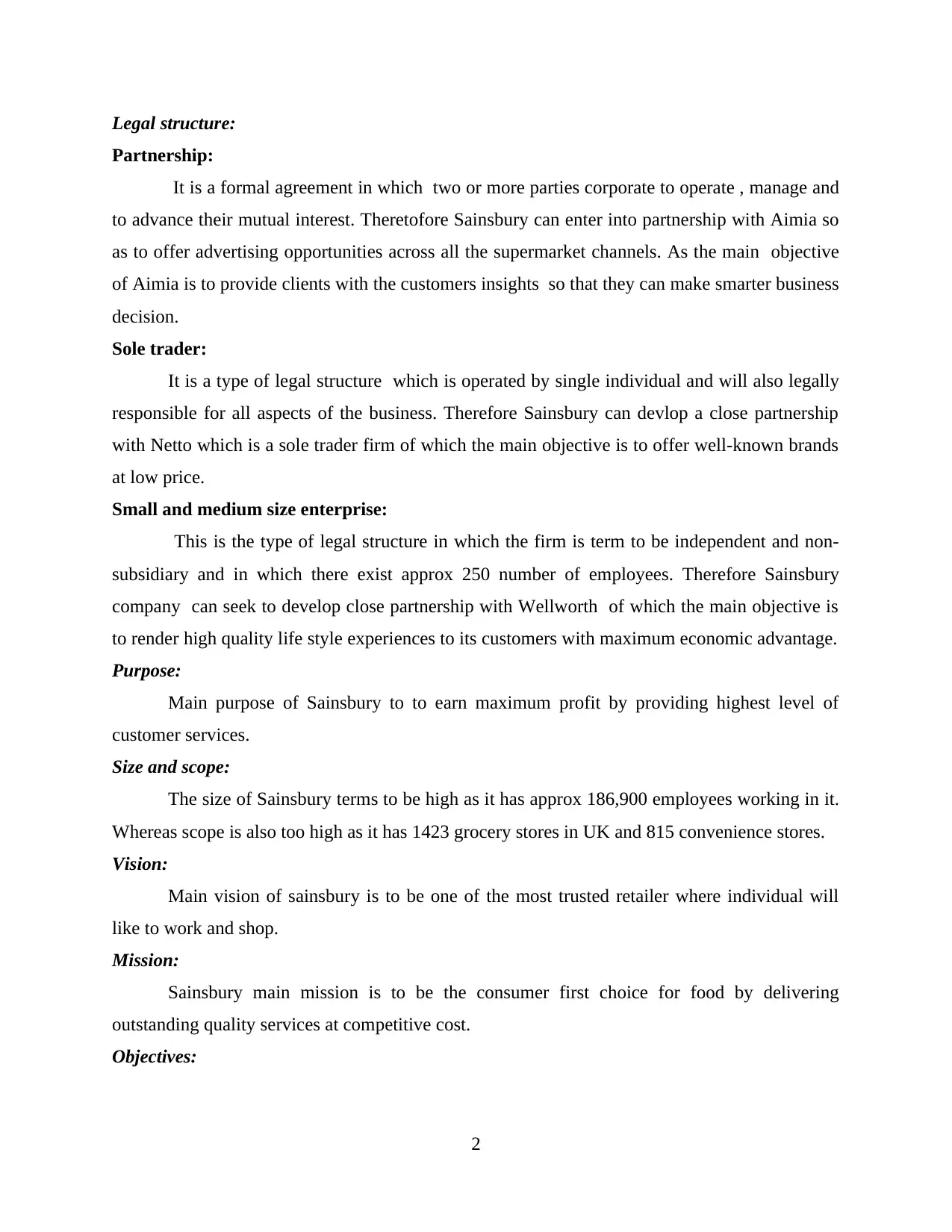
Legal structure:
Partnership:
It is a formal agreement in which two or more parties corporate to operate , manage and
to advance their mutual interest. Theretofore Sainsbury can enter into partnership with Aimia so
as to offer advertising opportunities across all the supermarket channels. As the main objective
of Aimia is to provide clients with the customers insights so that they can make smarter business
decision.
Sole trader:
It is a type of legal structure which is operated by single individual and will also legally
responsible for all aspects of the business. Therefore Sainsbury can devlop a close partnership
with Netto which is a sole trader firm of which the main objective is to offer well-known brands
at low price.
Small and medium size enterprise:
This is the type of legal structure in which the firm is term to be independent and non-
subsidiary and in which there exist approx 250 number of employees. Therefore Sainsbury
company can seek to develop close partnership with Wellworth of which the main objective is
to render high quality life style experiences to its customers with maximum economic advantage.
Purpose:
Main purpose of Sainsbury to to earn maximum profit by providing highest level of
customer services.
Size and scope:
The size of Sainsbury terms to be high as it has approx 186,900 employees working in it.
Whereas scope is also too high as it has 1423 grocery stores in UK and 815 convenience stores.
Vision:
Main vision of sainsbury is to be one of the most trusted retailer where individual will
like to work and shop.
Mission:
Sainsbury main mission is to be the consumer first choice for food by delivering
outstanding quality services at competitive cost.
Objectives:
2
Partnership:
It is a formal agreement in which two or more parties corporate to operate , manage and
to advance their mutual interest. Theretofore Sainsbury can enter into partnership with Aimia so
as to offer advertising opportunities across all the supermarket channels. As the main objective
of Aimia is to provide clients with the customers insights so that they can make smarter business
decision.
Sole trader:
It is a type of legal structure which is operated by single individual and will also legally
responsible for all aspects of the business. Therefore Sainsbury can devlop a close partnership
with Netto which is a sole trader firm of which the main objective is to offer well-known brands
at low price.
Small and medium size enterprise:
This is the type of legal structure in which the firm is term to be independent and non-
subsidiary and in which there exist approx 250 number of employees. Therefore Sainsbury
company can seek to develop close partnership with Wellworth of which the main objective is
to render high quality life style experiences to its customers with maximum economic advantage.
Purpose:
Main purpose of Sainsbury to to earn maximum profit by providing highest level of
customer services.
Size and scope:
The size of Sainsbury terms to be high as it has approx 186,900 employees working in it.
Whereas scope is also too high as it has 1423 grocery stores in UK and 815 convenience stores.
Vision:
Main vision of sainsbury is to be one of the most trusted retailer where individual will
like to work and shop.
Mission:
Sainsbury main mission is to be the consumer first choice for food by delivering
outstanding quality services at competitive cost.
Objectives:
2
Secure Best Marks with AI Grader
Need help grading? Try our AI Grader for instant feedback on your assignments.

Main objective of Sainsbury to to render high quality products to customer so as to meet
customer satisfaction level.
Public:
These are those organisation of which 50% share are bing hold by local or central
government. One such public organisation is NHS which is public funded national health care
system and was founded in 1948 by Aneurin Bevan. In addition to this it is engage in all the
three type of sector namely primary, secondary and territory.
Legal structure: Local government: This is the legal structure under which the government possess
control and monitor over smaller part of nation like district or city. State government:Role of state government is to regulate and to handle and to share
political power with national or federal government. Central government:This government hold absolute supremacy over unitary state and are
responsible for sustainable economic development and to improve the quality of the
environment.
Purpose:
Main purpose of NHS is to raise the standard of health care services.
Size and scope:
Size of NHS term to be high as here work near about 14,00,000 number of employees.
Whereas the scope also term to be high as it render different types of free services such as
emergency treatment, treatment of infectious diseases etc.
Vision:
Main vision of NHS is to maximise well-being and to prevent illness.
Mission:
Main mission of NHS is to deliver better health for communities through individual
focused scheme.
Objectives:
Main objective of NHS is to keep people well by delivering better care through quick
access to modern services.
Voluntary:
3
customer satisfaction level.
Public:
These are those organisation of which 50% share are bing hold by local or central
government. One such public organisation is NHS which is public funded national health care
system and was founded in 1948 by Aneurin Bevan. In addition to this it is engage in all the
three type of sector namely primary, secondary and territory.
Legal structure: Local government: This is the legal structure under which the government possess
control and monitor over smaller part of nation like district or city. State government:Role of state government is to regulate and to handle and to share
political power with national or federal government. Central government:This government hold absolute supremacy over unitary state and are
responsible for sustainable economic development and to improve the quality of the
environment.
Purpose:
Main purpose of NHS is to raise the standard of health care services.
Size and scope:
Size of NHS term to be high as here work near about 14,00,000 number of employees.
Whereas the scope also term to be high as it render different types of free services such as
emergency treatment, treatment of infectious diseases etc.
Vision:
Main vision of NHS is to maximise well-being and to prevent illness.
Mission:
Main mission of NHS is to deliver better health for communities through individual
focused scheme.
Objectives:
Main objective of NHS is to keep people well by delivering better care through quick
access to modern services.
Voluntary:
3
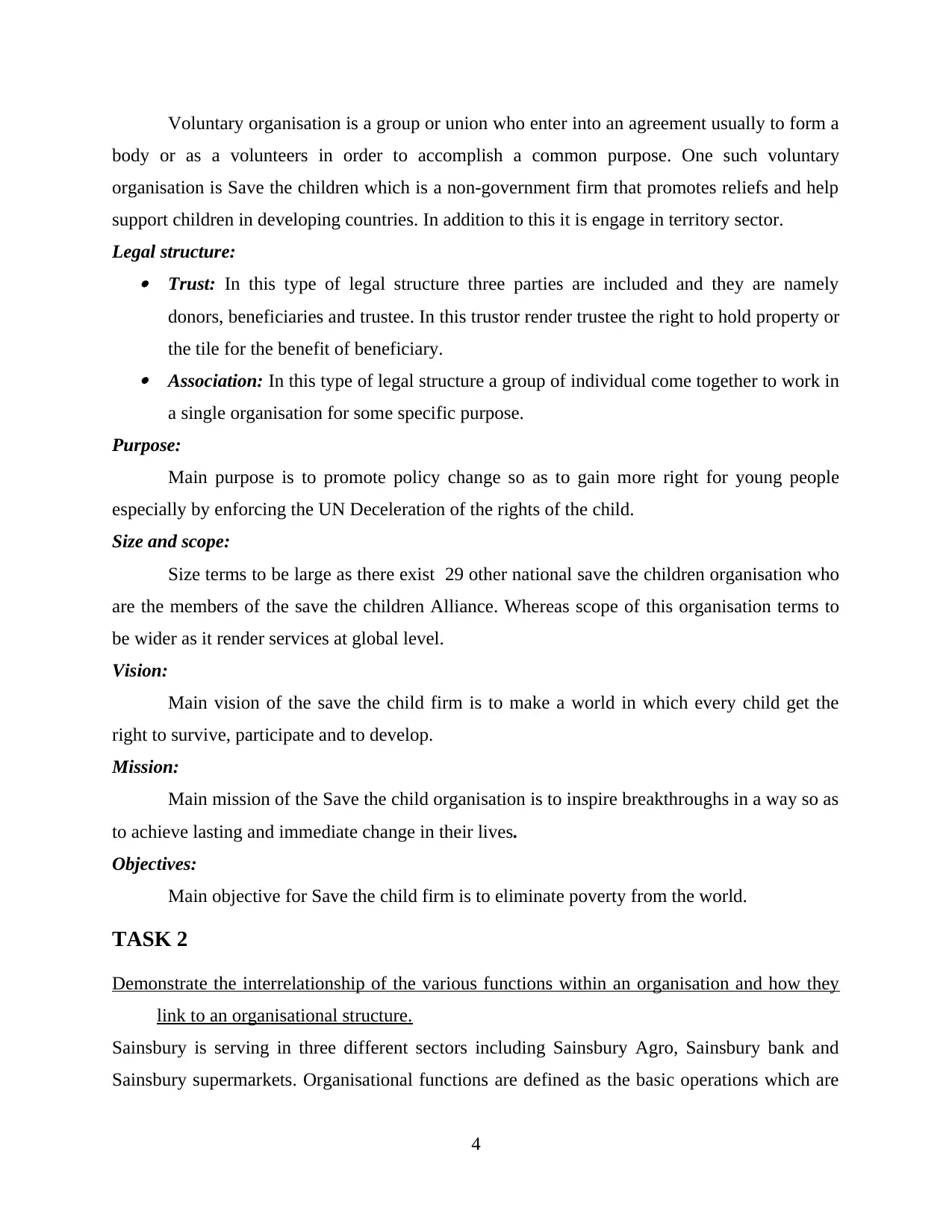
Voluntary organisation is a group or union who enter into an agreement usually to form a
body or as a volunteers in order to accomplish a common purpose. One such voluntary
organisation is Save the children which is a non-government firm that promotes reliefs and help
support children in developing countries. In addition to this it is engage in territory sector.
Legal structure: Trust: In this type of legal structure three parties are included and they are namely
donors, beneficiaries and trustee. In this trustor render trustee the right to hold property or
the tile for the benefit of beneficiary. Association: In this type of legal structure a group of individual come together to work in
a single organisation for some specific purpose.
Purpose:
Main purpose is to promote policy change so as to gain more right for young people
especially by enforcing the UN Deceleration of the rights of the child.
Size and scope:
Size terms to be large as there exist 29 other national save the children organisation who
are the members of the save the children Alliance. Whereas scope of this organisation terms to
be wider as it render services at global level.
Vision:
Main vision of the save the child firm is to make a world in which every child get the
right to survive, participate and to develop.
Mission:
Main mission of the Save the child organisation is to inspire breakthroughs in a way so as
to achieve lasting and immediate change in their lives.
Objectives:
Main objective for Save the child firm is to eliminate poverty from the world.
TASK 2
Demonstrate the interrelationship of the various functions within an organisation and how they
link to an organisational structure.
Sainsbury is serving in three different sectors including Sainsbury Agro, Sainsbury bank and
Sainsbury supermarkets. Organisational functions are defined as the basic operations which are
4
body or as a volunteers in order to accomplish a common purpose. One such voluntary
organisation is Save the children which is a non-government firm that promotes reliefs and help
support children in developing countries. In addition to this it is engage in territory sector.
Legal structure: Trust: In this type of legal structure three parties are included and they are namely
donors, beneficiaries and trustee. In this trustor render trustee the right to hold property or
the tile for the benefit of beneficiary. Association: In this type of legal structure a group of individual come together to work in
a single organisation for some specific purpose.
Purpose:
Main purpose is to promote policy change so as to gain more right for young people
especially by enforcing the UN Deceleration of the rights of the child.
Size and scope:
Size terms to be large as there exist 29 other national save the children organisation who
are the members of the save the children Alliance. Whereas scope of this organisation terms to
be wider as it render services at global level.
Vision:
Main vision of the save the child firm is to make a world in which every child get the
right to survive, participate and to develop.
Mission:
Main mission of the Save the child organisation is to inspire breakthroughs in a way so as
to achieve lasting and immediate change in their lives.
Objectives:
Main objective for Save the child firm is to eliminate poverty from the world.
TASK 2
Demonstrate the interrelationship of the various functions within an organisation and how they
link to an organisational structure.
Sainsbury is serving in three different sectors including Sainsbury Agro, Sainsbury bank and
Sainsbury supermarkets. Organisational functions are defined as the basic operations which are
4
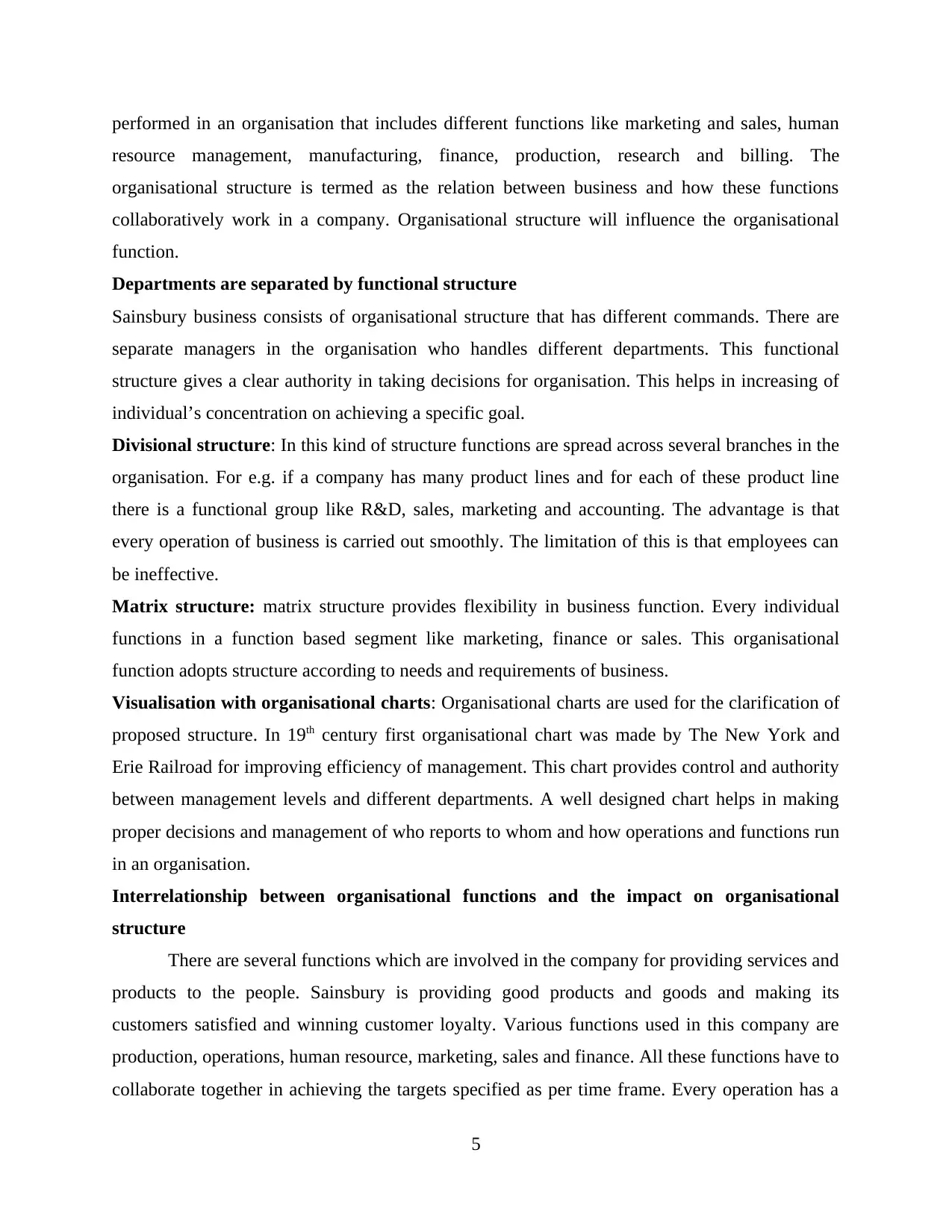
performed in an organisation that includes different functions like marketing and sales, human
resource management, manufacturing, finance, production, research and billing. The
organisational structure is termed as the relation between business and how these functions
collaboratively work in a company. Organisational structure will influence the organisational
function.
Departments are separated by functional structure
Sainsbury business consists of organisational structure that has different commands. There are
separate managers in the organisation who handles different departments. This functional
structure gives a clear authority in taking decisions for organisation. This helps in increasing of
individual’s concentration on achieving a specific goal.
Divisional structure: In this kind of structure functions are spread across several branches in the
organisation. For e.g. if a company has many product lines and for each of these product line
there is a functional group like R&D, sales, marketing and accounting. The advantage is that
every operation of business is carried out smoothly. The limitation of this is that employees can
be ineffective.
Matrix structure: matrix structure provides flexibility in business function. Every individual
functions in a function based segment like marketing, finance or sales. This organisational
function adopts structure according to needs and requirements of business.
Visualisation with organisational charts: Organisational charts are used for the clarification of
proposed structure. In 19th century first organisational chart was made by The New York and
Erie Railroad for improving efficiency of management. This chart provides control and authority
between management levels and different departments. A well designed chart helps in making
proper decisions and management of who reports to whom and how operations and functions run
in an organisation.
Interrelationship between organisational functions and the impact on organisational
structure
There are several functions which are involved in the company for providing services and
products to the people. Sainsbury is providing good products and goods and making its
customers satisfied and winning customer loyalty. Various functions used in this company are
production, operations, human resource, marketing, sales and finance. All these functions have to
collaborate together in achieving the targets specified as per time frame. Every operation has a
5
resource management, manufacturing, finance, production, research and billing. The
organisational structure is termed as the relation between business and how these functions
collaboratively work in a company. Organisational structure will influence the organisational
function.
Departments are separated by functional structure
Sainsbury business consists of organisational structure that has different commands. There are
separate managers in the organisation who handles different departments. This functional
structure gives a clear authority in taking decisions for organisation. This helps in increasing of
individual’s concentration on achieving a specific goal.
Divisional structure: In this kind of structure functions are spread across several branches in the
organisation. For e.g. if a company has many product lines and for each of these product line
there is a functional group like R&D, sales, marketing and accounting. The advantage is that
every operation of business is carried out smoothly. The limitation of this is that employees can
be ineffective.
Matrix structure: matrix structure provides flexibility in business function. Every individual
functions in a function based segment like marketing, finance or sales. This organisational
function adopts structure according to needs and requirements of business.
Visualisation with organisational charts: Organisational charts are used for the clarification of
proposed structure. In 19th century first organisational chart was made by The New York and
Erie Railroad for improving efficiency of management. This chart provides control and authority
between management levels and different departments. A well designed chart helps in making
proper decisions and management of who reports to whom and how operations and functions run
in an organisation.
Interrelationship between organisational functions and the impact on organisational
structure
There are several functions which are involved in the company for providing services and
products to the people. Sainsbury is providing good products and goods and making its
customers satisfied and winning customer loyalty. Various functions used in this company are
production, operations, human resource, marketing, sales and finance. All these functions have to
collaborate together in achieving the targets specified as per time frame. Every operation has a
5
Paraphrase This Document
Need a fresh take? Get an instant paraphrase of this document with our AI Paraphraser
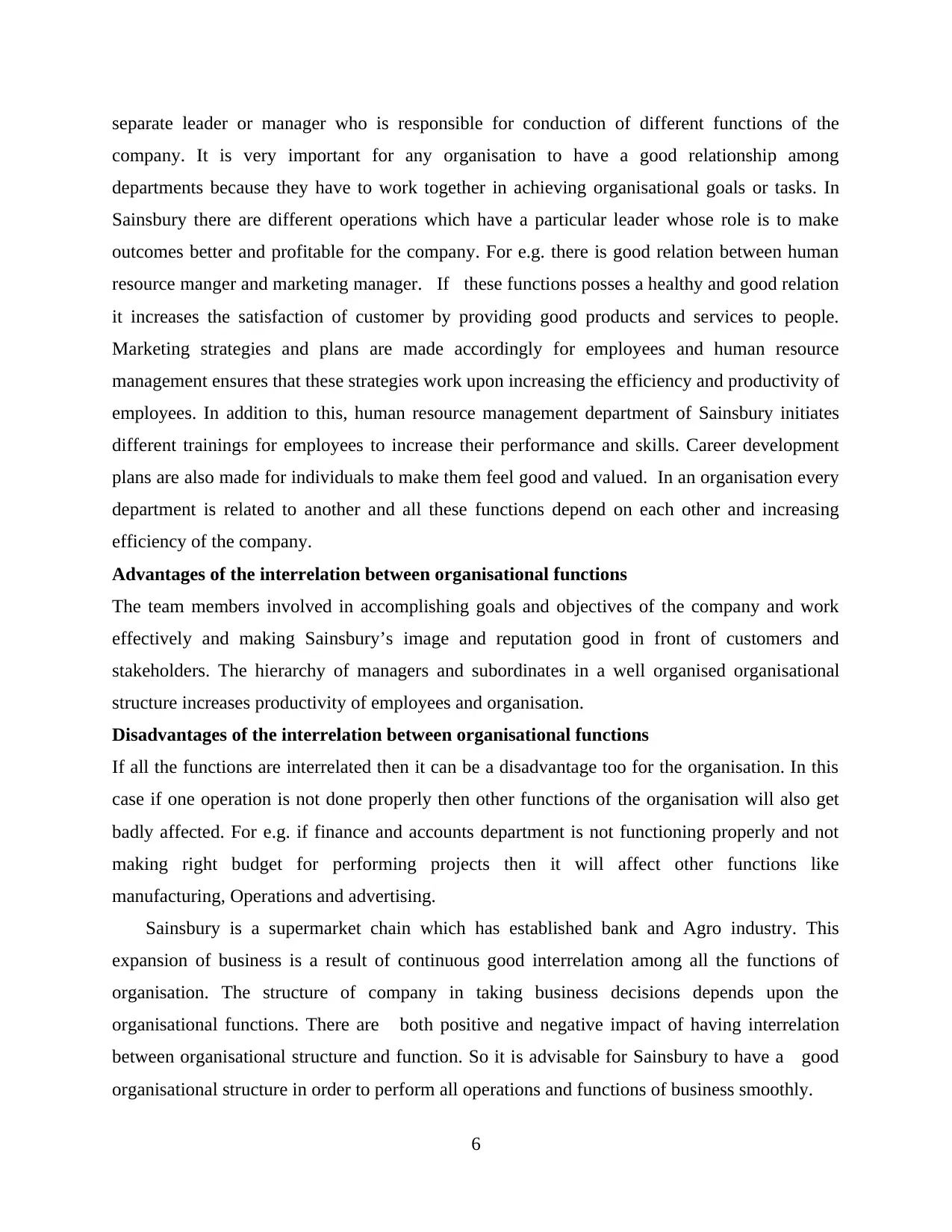
separate leader or manager who is responsible for conduction of different functions of the
company. It is very important for any organisation to have a good relationship among
departments because they have to work together in achieving organisational goals or tasks. In
Sainsbury there are different operations which have a particular leader whose role is to make
outcomes better and profitable for the company. For e.g. there is good relation between human
resource manger and marketing manager. If these functions posses a healthy and good relation
it increases the satisfaction of customer by providing good products and services to people.
Marketing strategies and plans are made accordingly for employees and human resource
management ensures that these strategies work upon increasing the efficiency and productivity of
employees. In addition to this, human resource management department of Sainsbury initiates
different trainings for employees to increase their performance and skills. Career development
plans are also made for individuals to make them feel good and valued. In an organisation every
department is related to another and all these functions depend on each other and increasing
efficiency of the company.
Advantages of the interrelation between organisational functions
The team members involved in accomplishing goals and objectives of the company and work
effectively and making Sainsbury’s image and reputation good in front of customers and
stakeholders. The hierarchy of managers and subordinates in a well organised organisational
structure increases productivity of employees and organisation.
Disadvantages of the interrelation between organisational functions
If all the functions are interrelated then it can be a disadvantage too for the organisation. In this
case if one operation is not done properly then other functions of the organisation will also get
badly affected. For e.g. if finance and accounts department is not functioning properly and not
making right budget for performing projects then it will affect other functions like
manufacturing, Operations and advertising.
Sainsbury is a supermarket chain which has established bank and Agro industry. This
expansion of business is a result of continuous good interrelation among all the functions of
organisation. The structure of company in taking business decisions depends upon the
organisational functions. There are both positive and negative impact of having interrelation
between organisational structure and function. So it is advisable for Sainsbury to have a good
organisational structure in order to perform all operations and functions of business smoothly.
6
company. It is very important for any organisation to have a good relationship among
departments because they have to work together in achieving organisational goals or tasks. In
Sainsbury there are different operations which have a particular leader whose role is to make
outcomes better and profitable for the company. For e.g. there is good relation between human
resource manger and marketing manager. If these functions posses a healthy and good relation
it increases the satisfaction of customer by providing good products and services to people.
Marketing strategies and plans are made accordingly for employees and human resource
management ensures that these strategies work upon increasing the efficiency and productivity of
employees. In addition to this, human resource management department of Sainsbury initiates
different trainings for employees to increase their performance and skills. Career development
plans are also made for individuals to make them feel good and valued. In an organisation every
department is related to another and all these functions depend on each other and increasing
efficiency of the company.
Advantages of the interrelation between organisational functions
The team members involved in accomplishing goals and objectives of the company and work
effectively and making Sainsbury’s image and reputation good in front of customers and
stakeholders. The hierarchy of managers and subordinates in a well organised organisational
structure increases productivity of employees and organisation.
Disadvantages of the interrelation between organisational functions
If all the functions are interrelated then it can be a disadvantage too for the organisation. In this
case if one operation is not done properly then other functions of the organisation will also get
badly affected. For e.g. if finance and accounts department is not functioning properly and not
making right budget for performing projects then it will affect other functions like
manufacturing, Operations and advertising.
Sainsbury is a supermarket chain which has established bank and Agro industry. This
expansion of business is a result of continuous good interrelation among all the functions of
organisation. The structure of company in taking business decisions depends upon the
organisational functions. There are both positive and negative impact of having interrelation
between organisational structure and function. So it is advisable for Sainsbury to have a good
organisational structure in order to perform all operations and functions of business smoothly.
6
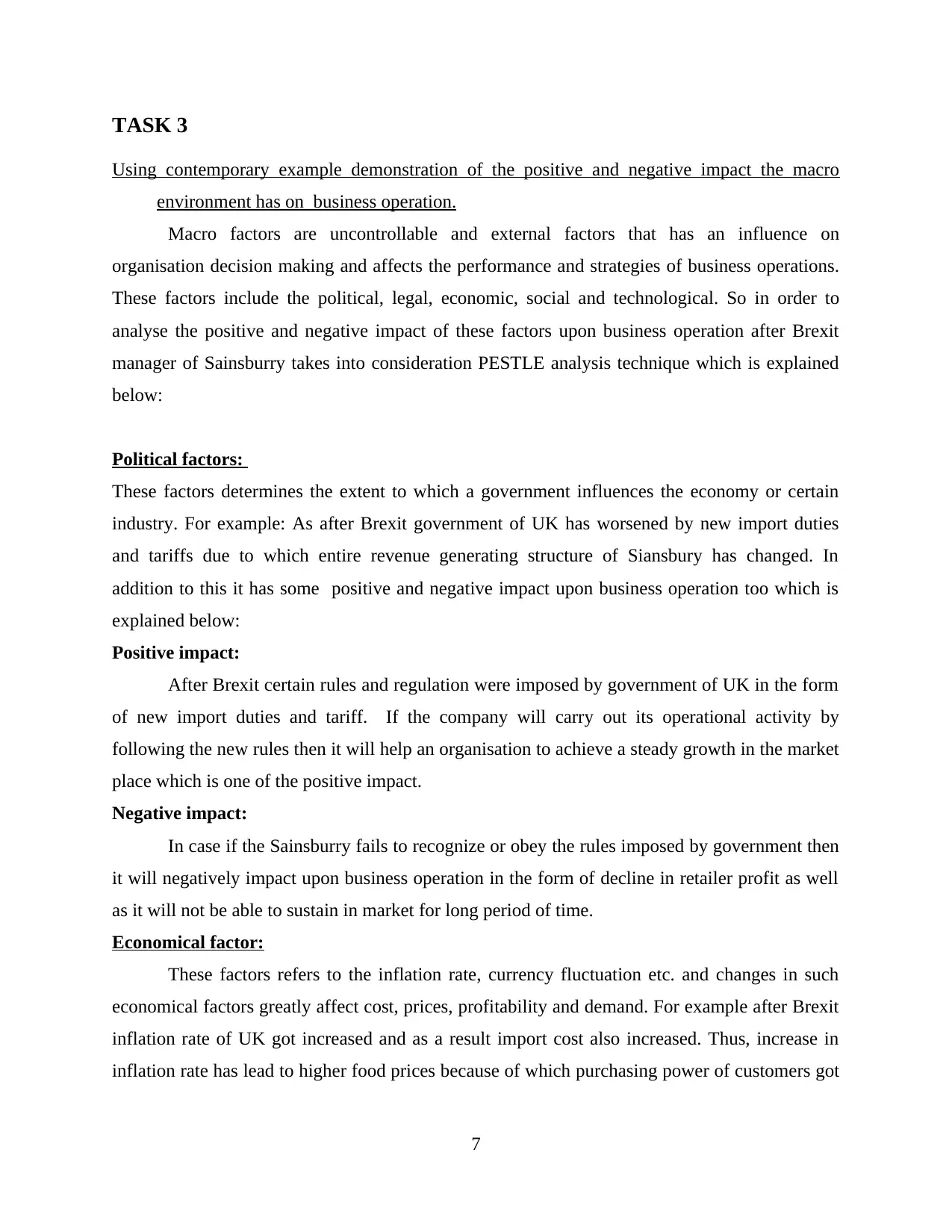
TASK 3
Using contemporary example demonstration of the positive and negative impact the macro
environment has on business operation.
Macro factors are uncontrollable and external factors that has an influence on
organisation decision making and affects the performance and strategies of business operations.
These factors include the political, legal, economic, social and technological. So in order to
analyse the positive and negative impact of these factors upon business operation after Brexit
manager of Sainsburry takes into consideration PESTLE analysis technique which is explained
below:
Political factors:
These factors determines the extent to which a government influences the economy or certain
industry. For example: As after Brexit government of UK has worsened by new import duties
and tariffs due to which entire revenue generating structure of Siansbury has changed. In
addition to this it has some positive and negative impact upon business operation too which is
explained below:
Positive impact:
After Brexit certain rules and regulation were imposed by government of UK in the form
of new import duties and tariff. If the company will carry out its operational activity by
following the new rules then it will help an organisation to achieve a steady growth in the market
place which is one of the positive impact.
Negative impact:
In case if the Sainsburry fails to recognize or obey the rules imposed by government then
it will negatively impact upon business operation in the form of decline in retailer profit as well
as it will not be able to sustain in market for long period of time.
Economical factor:
These factors refers to the inflation rate, currency fluctuation etc. and changes in such
economical factors greatly affect cost, prices, profitability and demand. For example after Brexit
inflation rate of UK got increased and as a result import cost also increased. Thus, increase in
inflation rate has lead to higher food prices because of which purchasing power of customers got
7
Using contemporary example demonstration of the positive and negative impact the macro
environment has on business operation.
Macro factors are uncontrollable and external factors that has an influence on
organisation decision making and affects the performance and strategies of business operations.
These factors include the political, legal, economic, social and technological. So in order to
analyse the positive and negative impact of these factors upon business operation after Brexit
manager of Sainsburry takes into consideration PESTLE analysis technique which is explained
below:
Political factors:
These factors determines the extent to which a government influences the economy or certain
industry. For example: As after Brexit government of UK has worsened by new import duties
and tariffs due to which entire revenue generating structure of Siansbury has changed. In
addition to this it has some positive and negative impact upon business operation too which is
explained below:
Positive impact:
After Brexit certain rules and regulation were imposed by government of UK in the form
of new import duties and tariff. If the company will carry out its operational activity by
following the new rules then it will help an organisation to achieve a steady growth in the market
place which is one of the positive impact.
Negative impact:
In case if the Sainsburry fails to recognize or obey the rules imposed by government then
it will negatively impact upon business operation in the form of decline in retailer profit as well
as it will not be able to sustain in market for long period of time.
Economical factor:
These factors refers to the inflation rate, currency fluctuation etc. and changes in such
economical factors greatly affect cost, prices, profitability and demand. For example after Brexit
inflation rate of UK got increased and as a result import cost also increased. Thus, increase in
inflation rate has lead to higher food prices because of which purchasing power of customers got
7
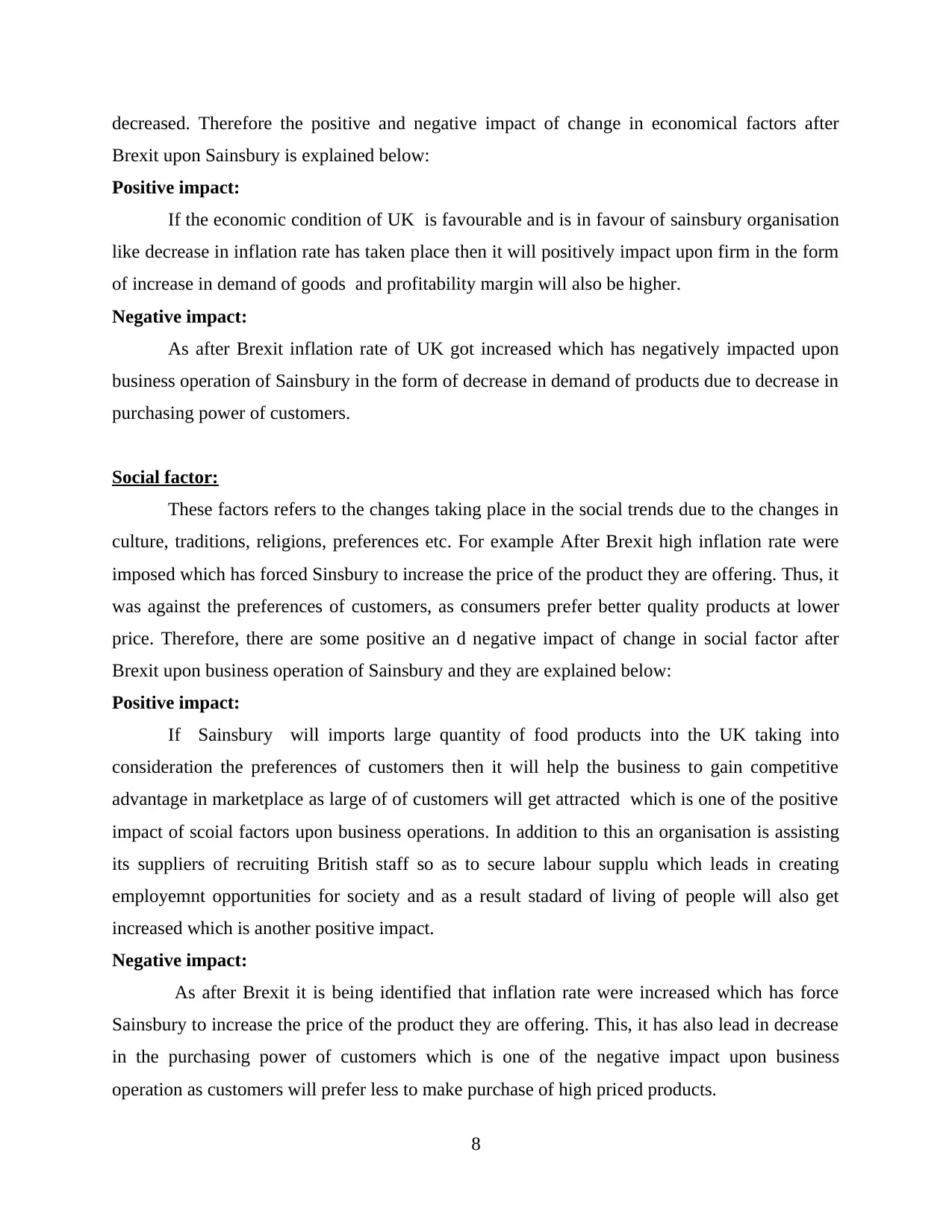
decreased. Therefore the positive and negative impact of change in economical factors after
Brexit upon Sainsbury is explained below:
Positive impact:
If the economic condition of UK is favourable and is in favour of sainsbury organisation
like decrease in inflation rate has taken place then it will positively impact upon firm in the form
of increase in demand of goods and profitability margin will also be higher.
Negative impact:
As after Brexit inflation rate of UK got increased which has negatively impacted upon
business operation of Sainsbury in the form of decrease in demand of products due to decrease in
purchasing power of customers.
Social factor:
These factors refers to the changes taking place in the social trends due to the changes in
culture, traditions, religions, preferences etc. For example After Brexit high inflation rate were
imposed which has forced Sinsbury to increase the price of the product they are offering. Thus, it
was against the preferences of customers, as consumers prefer better quality products at lower
price. Therefore, there are some positive an d negative impact of change in social factor after
Brexit upon business operation of Sainsbury and they are explained below:
Positive impact:
If Sainsbury will imports large quantity of food products into the UK taking into
consideration the preferences of customers then it will help the business to gain competitive
advantage in marketplace as large of of customers will get attracted which is one of the positive
impact of scoial factors upon business operations. In addition to this an organisation is assisting
its suppliers of recruiting British staff so as to secure labour supplu which leads in creating
employemnt opportunities for society and as a result stadard of living of people will also get
increased which is another positive impact.
Negative impact:
As after Brexit it is being identified that inflation rate were increased which has force
Sainsbury to increase the price of the product they are offering. This, it has also lead in decrease
in the purchasing power of customers which is one of the negative impact upon business
operation as customers will prefer less to make purchase of high priced products.
8
Brexit upon Sainsbury is explained below:
Positive impact:
If the economic condition of UK is favourable and is in favour of sainsbury organisation
like decrease in inflation rate has taken place then it will positively impact upon firm in the form
of increase in demand of goods and profitability margin will also be higher.
Negative impact:
As after Brexit inflation rate of UK got increased which has negatively impacted upon
business operation of Sainsbury in the form of decrease in demand of products due to decrease in
purchasing power of customers.
Social factor:
These factors refers to the changes taking place in the social trends due to the changes in
culture, traditions, religions, preferences etc. For example After Brexit high inflation rate were
imposed which has forced Sinsbury to increase the price of the product they are offering. Thus, it
was against the preferences of customers, as consumers prefer better quality products at lower
price. Therefore, there are some positive an d negative impact of change in social factor after
Brexit upon business operation of Sainsbury and they are explained below:
Positive impact:
If Sainsbury will imports large quantity of food products into the UK taking into
consideration the preferences of customers then it will help the business to gain competitive
advantage in marketplace as large of of customers will get attracted which is one of the positive
impact of scoial factors upon business operations. In addition to this an organisation is assisting
its suppliers of recruiting British staff so as to secure labour supplu which leads in creating
employemnt opportunities for society and as a result stadard of living of people will also get
increased which is another positive impact.
Negative impact:
As after Brexit it is being identified that inflation rate were increased which has force
Sainsbury to increase the price of the product they are offering. This, it has also lead in decrease
in the purchasing power of customers which is one of the negative impact upon business
operation as customers will prefer less to make purchase of high priced products.
8
Secure Best Marks with AI Grader
Need help grading? Try our AI Grader for instant feedback on your assignments.
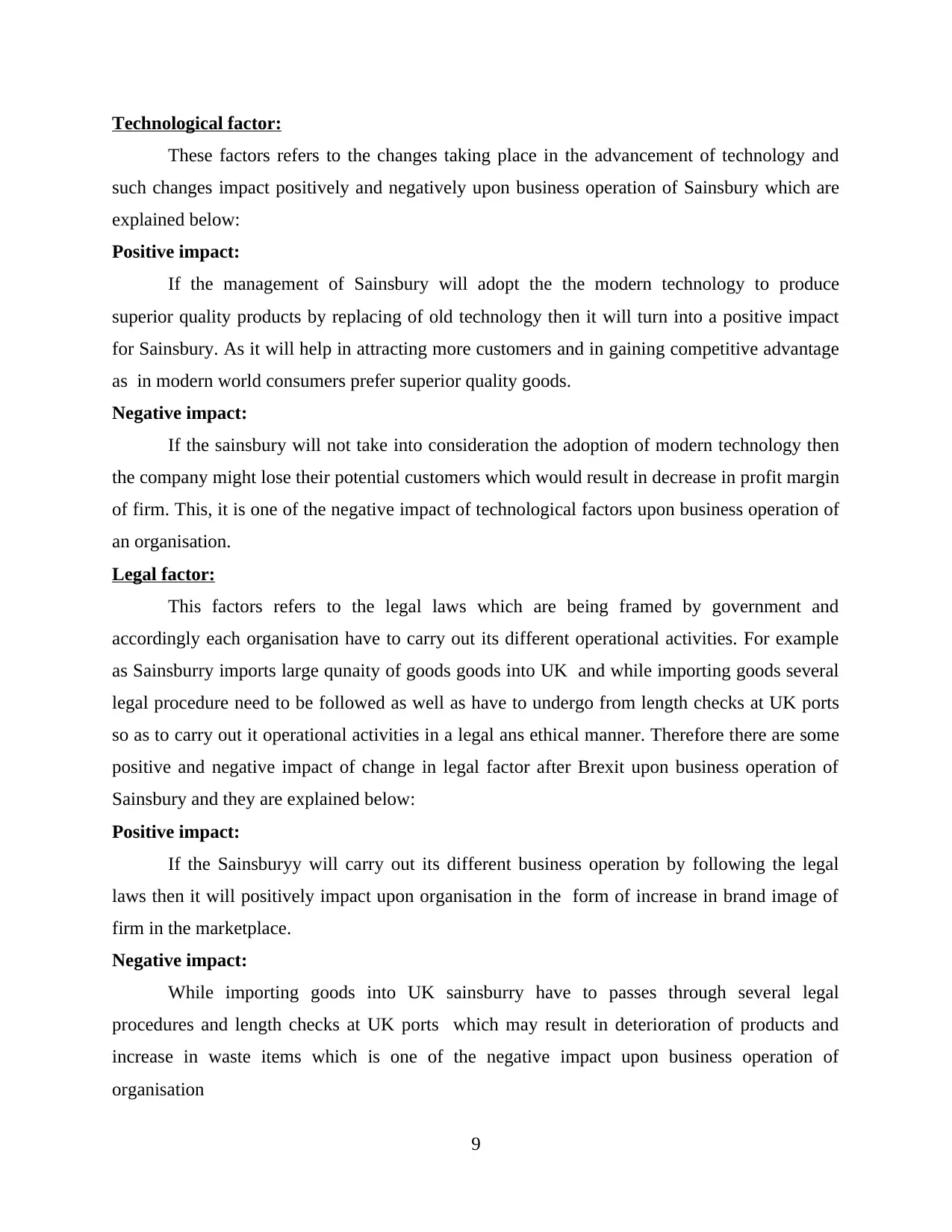
Technological factor:
These factors refers to the changes taking place in the advancement of technology and
such changes impact positively and negatively upon business operation of Sainsbury which are
explained below:
Positive impact:
If the management of Sainsbury will adopt the the modern technology to produce
superior quality products by replacing of old technology then it will turn into a positive impact
for Sainsbury. As it will help in attracting more customers and in gaining competitive advantage
as in modern world consumers prefer superior quality goods.
Negative impact:
If the sainsbury will not take into consideration the adoption of modern technology then
the company might lose their potential customers which would result in decrease in profit margin
of firm. This, it is one of the negative impact of technological factors upon business operation of
an organisation.
Legal factor:
This factors refers to the legal laws which are being framed by government and
accordingly each organisation have to carry out its different operational activities. For example
as Sainsburry imports large qunaity of goods goods into UK and while importing goods several
legal procedure need to be followed as well as have to undergo from length checks at UK ports
so as to carry out it operational activities in a legal ans ethical manner. Therefore there are some
positive and negative impact of change in legal factor after Brexit upon business operation of
Sainsbury and they are explained below:
Positive impact:
If the Sainsburyy will carry out its different business operation by following the legal
laws then it will positively impact upon organisation in the form of increase in brand image of
firm in the marketplace.
Negative impact:
While importing goods into UK sainsburry have to passes through several legal
procedures and length checks at UK ports which may result in deterioration of products and
increase in waste items which is one of the negative impact upon business operation of
organisation
9
These factors refers to the changes taking place in the advancement of technology and
such changes impact positively and negatively upon business operation of Sainsbury which are
explained below:
Positive impact:
If the management of Sainsbury will adopt the the modern technology to produce
superior quality products by replacing of old technology then it will turn into a positive impact
for Sainsbury. As it will help in attracting more customers and in gaining competitive advantage
as in modern world consumers prefer superior quality goods.
Negative impact:
If the sainsbury will not take into consideration the adoption of modern technology then
the company might lose their potential customers which would result in decrease in profit margin
of firm. This, it is one of the negative impact of technological factors upon business operation of
an organisation.
Legal factor:
This factors refers to the legal laws which are being framed by government and
accordingly each organisation have to carry out its different operational activities. For example
as Sainsburry imports large qunaity of goods goods into UK and while importing goods several
legal procedure need to be followed as well as have to undergo from length checks at UK ports
so as to carry out it operational activities in a legal ans ethical manner. Therefore there are some
positive and negative impact of change in legal factor after Brexit upon business operation of
Sainsbury and they are explained below:
Positive impact:
If the Sainsburyy will carry out its different business operation by following the legal
laws then it will positively impact upon organisation in the form of increase in brand image of
firm in the marketplace.
Negative impact:
While importing goods into UK sainsburry have to passes through several legal
procedures and length checks at UK ports which may result in deterioration of products and
increase in waste items which is one of the negative impact upon business operation of
organisation
9
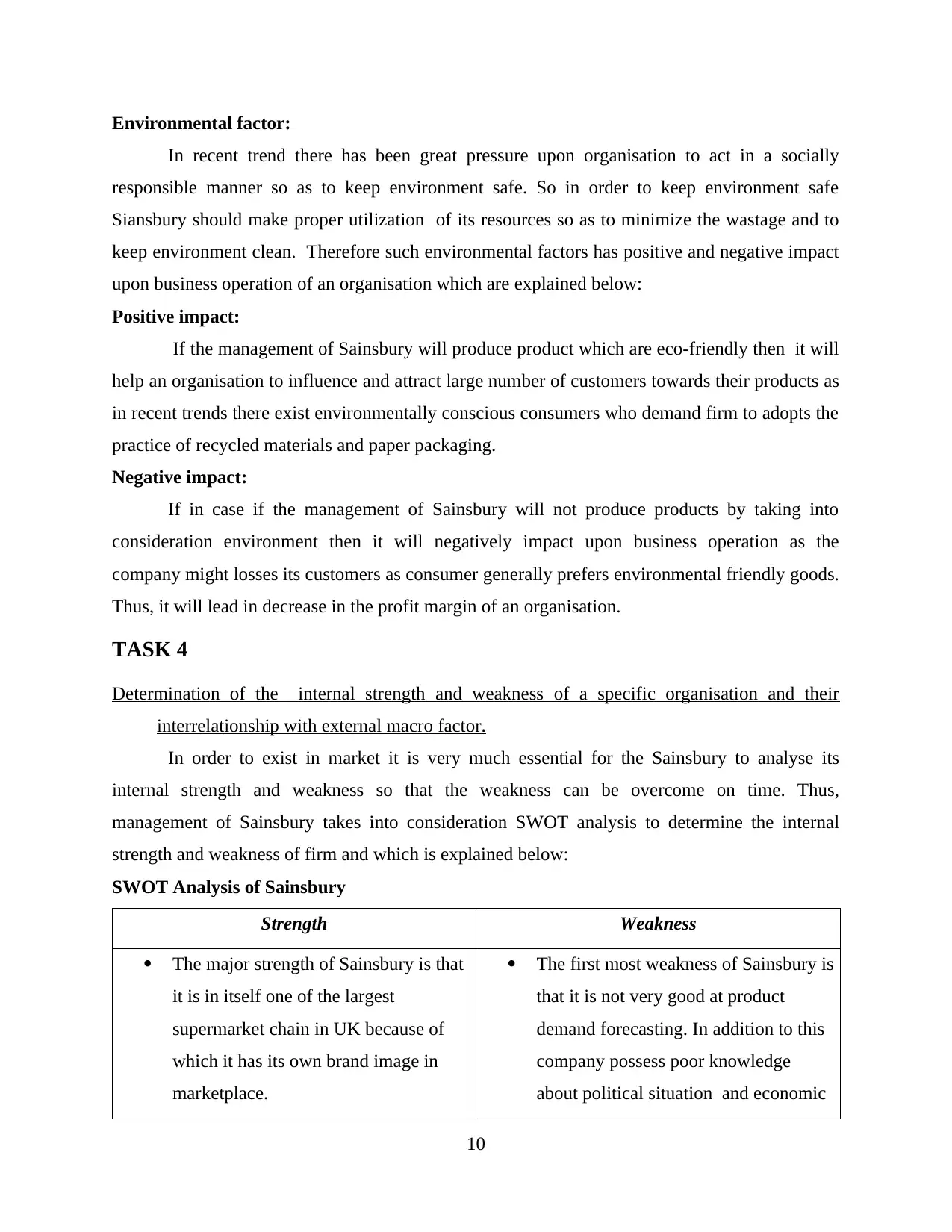
Environmental factor:
In recent trend there has been great pressure upon organisation to act in a socially
responsible manner so as to keep environment safe. So in order to keep environment safe
Siansbury should make proper utilization of its resources so as to minimize the wastage and to
keep environment clean. Therefore such environmental factors has positive and negative impact
upon business operation of an organisation which are explained below:
Positive impact:
If the management of Sainsbury will produce product which are eco-friendly then it will
help an organisation to influence and attract large number of customers towards their products as
in recent trends there exist environmentally conscious consumers who demand firm to adopts the
practice of recycled materials and paper packaging.
Negative impact:
If in case if the management of Sainsbury will not produce products by taking into
consideration environment then it will negatively impact upon business operation as the
company might losses its customers as consumer generally prefers environmental friendly goods.
Thus, it will lead in decrease in the profit margin of an organisation.
TASK 4
Determination of the internal strength and weakness of a specific organisation and their
interrelationship with external macro factor.
In order to exist in market it is very much essential for the Sainsbury to analyse its
internal strength and weakness so that the weakness can be overcome on time. Thus,
management of Sainsbury takes into consideration SWOT analysis to determine the internal
strength and weakness of firm and which is explained below:
SWOT Analysis of Sainsbury
Strength Weakness
The major strength of Sainsbury is that
it is in itself one of the largest
supermarket chain in UK because of
which it has its own brand image in
marketplace.
The first most weakness of Sainsbury is
that it is not very good at product
demand forecasting. In addition to this
company possess poor knowledge
about political situation and economic
10
In recent trend there has been great pressure upon organisation to act in a socially
responsible manner so as to keep environment safe. So in order to keep environment safe
Siansbury should make proper utilization of its resources so as to minimize the wastage and to
keep environment clean. Therefore such environmental factors has positive and negative impact
upon business operation of an organisation which are explained below:
Positive impact:
If the management of Sainsbury will produce product which are eco-friendly then it will
help an organisation to influence and attract large number of customers towards their products as
in recent trends there exist environmentally conscious consumers who demand firm to adopts the
practice of recycled materials and paper packaging.
Negative impact:
If in case if the management of Sainsbury will not produce products by taking into
consideration environment then it will negatively impact upon business operation as the
company might losses its customers as consumer generally prefers environmental friendly goods.
Thus, it will lead in decrease in the profit margin of an organisation.
TASK 4
Determination of the internal strength and weakness of a specific organisation and their
interrelationship with external macro factor.
In order to exist in market it is very much essential for the Sainsbury to analyse its
internal strength and weakness so that the weakness can be overcome on time. Thus,
management of Sainsbury takes into consideration SWOT analysis to determine the internal
strength and weakness of firm and which is explained below:
SWOT Analysis of Sainsbury
Strength Weakness
The major strength of Sainsbury is that
it is in itself one of the largest
supermarket chain in UK because of
which it has its own brand image in
marketplace.
The first most weakness of Sainsbury is
that it is not very good at product
demand forecasting. In addition to this
company possess poor knowledge
about political situation and economic
10
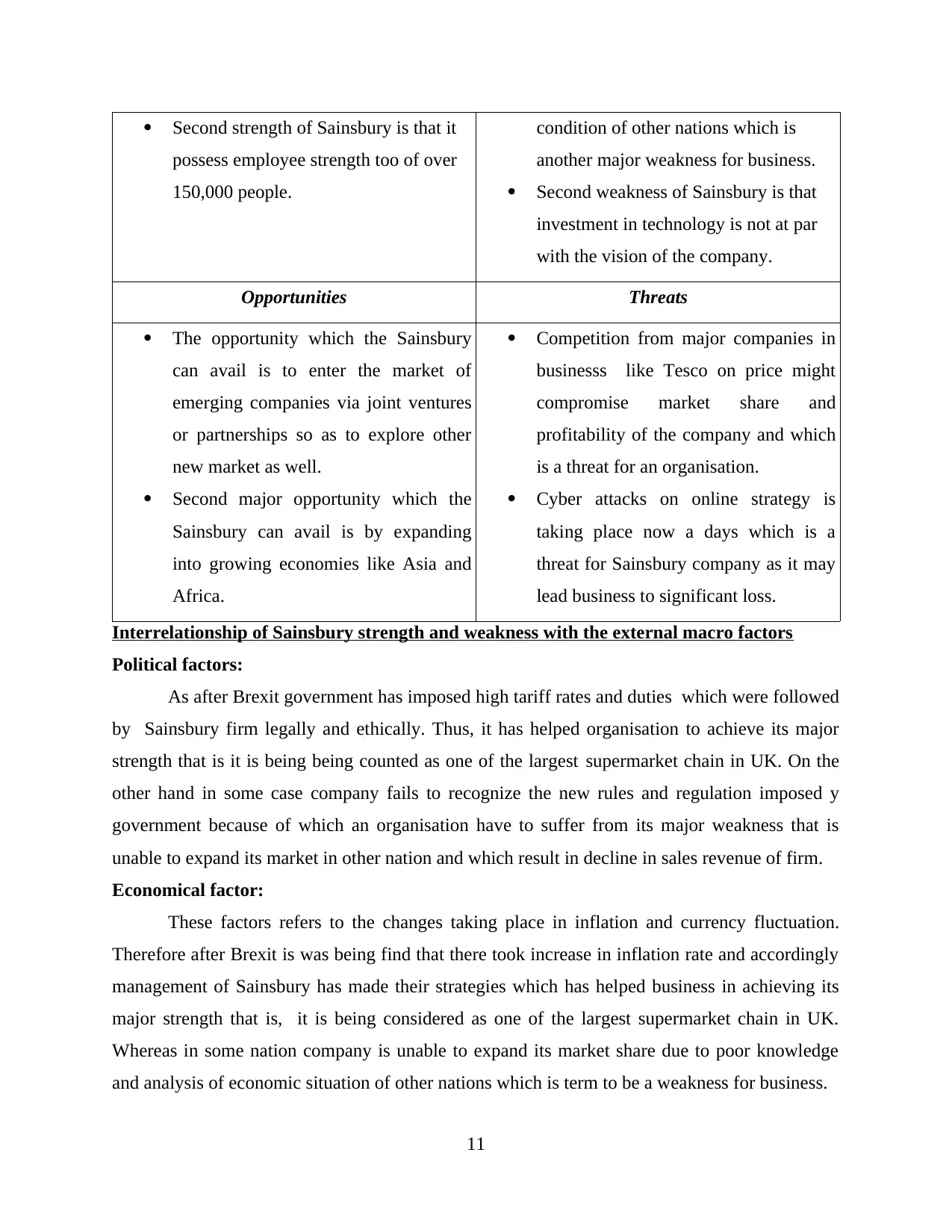
Second strength of Sainsbury is that it
possess employee strength too of over
150,000 people.
condition of other nations which is
another major weakness for business.
Second weakness of Sainsbury is that
investment in technology is not at par
with the vision of the company.
Opportunities Threats
The opportunity which the Sainsbury
can avail is to enter the market of
emerging companies via joint ventures
or partnerships so as to explore other
new market as well.
Second major opportunity which the
Sainsbury can avail is by expanding
into growing economies like Asia and
Africa.
Competition from major companies in
businesss like Tesco on price might
compromise market share and
profitability of the company and which
is a threat for an organisation.
Cyber attacks on online strategy is
taking place now a days which is a
threat for Sainsbury company as it may
lead business to significant loss.
Interrelationship of Sainsbury strength and weakness with the external macro factors
Political factors:
As after Brexit government has imposed high tariff rates and duties which were followed
by Sainsbury firm legally and ethically. Thus, it has helped organisation to achieve its major
strength that is it is being being counted as one of the largest supermarket chain in UK. On the
other hand in some case company fails to recognize the new rules and regulation imposed y
government because of which an organisation have to suffer from its major weakness that is
unable to expand its market in other nation and which result in decline in sales revenue of firm.
Economical factor:
These factors refers to the changes taking place in inflation and currency fluctuation.
Therefore after Brexit is was being find that there took increase in inflation rate and accordingly
management of Sainsbury has made their strategies which has helped business in achieving its
major strength that is, it is being considered as one of the largest supermarket chain in UK.
Whereas in some nation company is unable to expand its market share due to poor knowledge
and analysis of economic situation of other nations which is term to be a weakness for business.
11
possess employee strength too of over
150,000 people.
condition of other nations which is
another major weakness for business.
Second weakness of Sainsbury is that
investment in technology is not at par
with the vision of the company.
Opportunities Threats
The opportunity which the Sainsbury
can avail is to enter the market of
emerging companies via joint ventures
or partnerships so as to explore other
new market as well.
Second major opportunity which the
Sainsbury can avail is by expanding
into growing economies like Asia and
Africa.
Competition from major companies in
businesss like Tesco on price might
compromise market share and
profitability of the company and which
is a threat for an organisation.
Cyber attacks on online strategy is
taking place now a days which is a
threat for Sainsbury company as it may
lead business to significant loss.
Interrelationship of Sainsbury strength and weakness with the external macro factors
Political factors:
As after Brexit government has imposed high tariff rates and duties which were followed
by Sainsbury firm legally and ethically. Thus, it has helped organisation to achieve its major
strength that is it is being being counted as one of the largest supermarket chain in UK. On the
other hand in some case company fails to recognize the new rules and regulation imposed y
government because of which an organisation have to suffer from its major weakness that is
unable to expand its market in other nation and which result in decline in sales revenue of firm.
Economical factor:
These factors refers to the changes taking place in inflation and currency fluctuation.
Therefore after Brexit is was being find that there took increase in inflation rate and accordingly
management of Sainsbury has made their strategies which has helped business in achieving its
major strength that is, it is being considered as one of the largest supermarket chain in UK.
Whereas in some nation company is unable to expand its market share due to poor knowledge
and analysis of economic situation of other nations which is term to be a weakness for business.
11
Paraphrase This Document
Need a fresh take? Get an instant paraphrase of this document with our AI Paraphraser
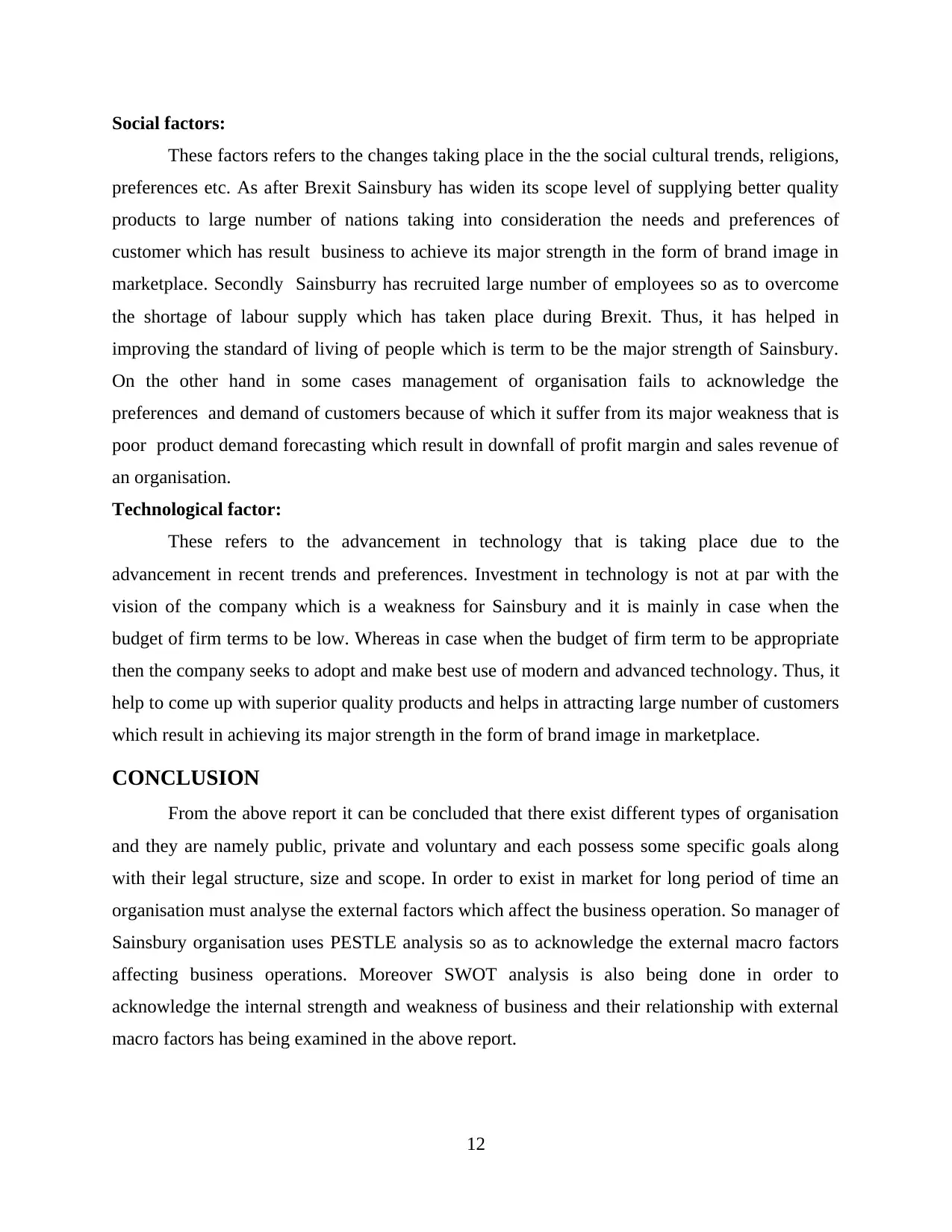
Social factors:
These factors refers to the changes taking place in the the social cultural trends, religions,
preferences etc. As after Brexit Sainsbury has widen its scope level of supplying better quality
products to large number of nations taking into consideration the needs and preferences of
customer which has result business to achieve its major strength in the form of brand image in
marketplace. Secondly Sainsburry has recruited large number of employees so as to overcome
the shortage of labour supply which has taken place during Brexit. Thus, it has helped in
improving the standard of living of people which is term to be the major strength of Sainsbury.
On the other hand in some cases management of organisation fails to acknowledge the
preferences and demand of customers because of which it suffer from its major weakness that is
poor product demand forecasting which result in downfall of profit margin and sales revenue of
an organisation.
Technological factor:
These refers to the advancement in technology that is taking place due to the
advancement in recent trends and preferences. Investment in technology is not at par with the
vision of the company which is a weakness for Sainsbury and it is mainly in case when the
budget of firm terms to be low. Whereas in case when the budget of firm term to be appropriate
then the company seeks to adopt and make best use of modern and advanced technology. Thus, it
help to come up with superior quality products and helps in attracting large number of customers
which result in achieving its major strength in the form of brand image in marketplace.
CONCLUSION
From the above report it can be concluded that there exist different types of organisation
and they are namely public, private and voluntary and each possess some specific goals along
with their legal structure, size and scope. In order to exist in market for long period of time an
organisation must analyse the external factors which affect the business operation. So manager of
Sainsbury organisation uses PESTLE analysis so as to acknowledge the external macro factors
affecting business operations. Moreover SWOT analysis is also being done in order to
acknowledge the internal strength and weakness of business and their relationship with external
macro factors has being examined in the above report.
12
These factors refers to the changes taking place in the the social cultural trends, religions,
preferences etc. As after Brexit Sainsbury has widen its scope level of supplying better quality
products to large number of nations taking into consideration the needs and preferences of
customer which has result business to achieve its major strength in the form of brand image in
marketplace. Secondly Sainsburry has recruited large number of employees so as to overcome
the shortage of labour supply which has taken place during Brexit. Thus, it has helped in
improving the standard of living of people which is term to be the major strength of Sainsbury.
On the other hand in some cases management of organisation fails to acknowledge the
preferences and demand of customers because of which it suffer from its major weakness that is
poor product demand forecasting which result in downfall of profit margin and sales revenue of
an organisation.
Technological factor:
These refers to the advancement in technology that is taking place due to the
advancement in recent trends and preferences. Investment in technology is not at par with the
vision of the company which is a weakness for Sainsbury and it is mainly in case when the
budget of firm terms to be low. Whereas in case when the budget of firm term to be appropriate
then the company seeks to adopt and make best use of modern and advanced technology. Thus, it
help to come up with superior quality products and helps in attracting large number of customers
which result in achieving its major strength in the form of brand image in marketplace.
CONCLUSION
From the above report it can be concluded that there exist different types of organisation
and they are namely public, private and voluntary and each possess some specific goals along
with their legal structure, size and scope. In order to exist in market for long period of time an
organisation must analyse the external factors which affect the business operation. So manager of
Sainsbury organisation uses PESTLE analysis so as to acknowledge the external macro factors
affecting business operations. Moreover SWOT analysis is also being done in order to
acknowledge the internal strength and weakness of business and their relationship with external
macro factors has being examined in the above report.
12

13
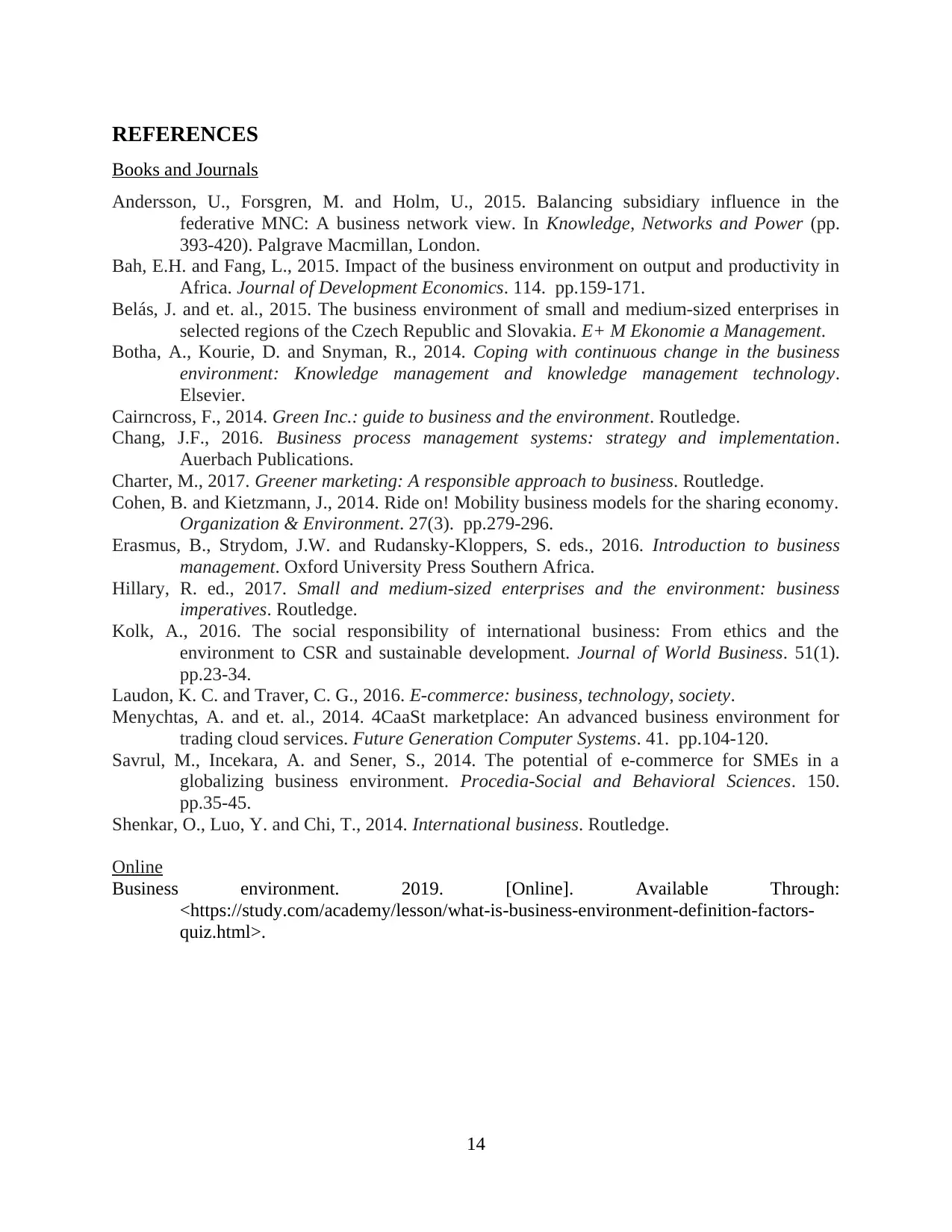
REFERENCES
Books and Journals
Andersson, U., Forsgren, M. and Holm, U., 2015. Balancing subsidiary influence in the
federative MNC: A business network view. In Knowledge, Networks and Power (pp.
393-420). Palgrave Macmillan, London.
Bah, E.H. and Fang, L., 2015. Impact of the business environment on output and productivity in
Africa. Journal of Development Economics. 114. pp.159-171.
Belás, J. and et. al., 2015. The business environment of small and medium-sized enterprises in
selected regions of the Czech Republic and Slovakia. E+ M Ekonomie a Management.
Botha, A., Kourie, D. and Snyman, R., 2014. Coping with continuous change in the business
environment: Knowledge management and knowledge management technology.
Elsevier.
Cairncross, F., 2014. Green Inc.: guide to business and the environment. Routledge.
Chang, J.F., 2016. Business process management systems: strategy and implementation.
Auerbach Publications.
Charter, M., 2017. Greener marketing: A responsible approach to business. Routledge.
Cohen, B. and Kietzmann, J., 2014. Ride on! Mobility business models for the sharing economy.
Organization & Environment. 27(3). pp.279-296.
Erasmus, B., Strydom, J.W. and Rudansky-Kloppers, S. eds., 2016. Introduction to business
management. Oxford University Press Southern Africa.
Hillary, R. ed., 2017. Small and medium-sized enterprises and the environment: business
imperatives. Routledge.
Kolk, A., 2016. The social responsibility of international business: From ethics and the
environment to CSR and sustainable development. Journal of World Business. 51(1).
pp.23-34.
Laudon, K. C. and Traver, C. G., 2016. E-commerce: business, technology, society.
Menychtas, A. and et. al., 2014. 4CaaSt marketplace: An advanced business environment for
trading cloud services. Future Generation Computer Systems. 41. pp.104-120.
Savrul, M., Incekara, A. and Sener, S., 2014. The potential of e-commerce for SMEs in a
globalizing business environment. Procedia-Social and Behavioral Sciences. 150.
pp.35-45.
Shenkar, O., Luo, Y. and Chi, T., 2014. International business. Routledge.
Online
Business environment. 2019. [Online]. Available Through:
<https://study.com/academy/lesson/what-is-business-environment-definition-factors-
quiz.html>.
14
Books and Journals
Andersson, U., Forsgren, M. and Holm, U., 2015. Balancing subsidiary influence in the
federative MNC: A business network view. In Knowledge, Networks and Power (pp.
393-420). Palgrave Macmillan, London.
Bah, E.H. and Fang, L., 2015. Impact of the business environment on output and productivity in
Africa. Journal of Development Economics. 114. pp.159-171.
Belás, J. and et. al., 2015. The business environment of small and medium-sized enterprises in
selected regions of the Czech Republic and Slovakia. E+ M Ekonomie a Management.
Botha, A., Kourie, D. and Snyman, R., 2014. Coping with continuous change in the business
environment: Knowledge management and knowledge management technology.
Elsevier.
Cairncross, F., 2014. Green Inc.: guide to business and the environment. Routledge.
Chang, J.F., 2016. Business process management systems: strategy and implementation.
Auerbach Publications.
Charter, M., 2017. Greener marketing: A responsible approach to business. Routledge.
Cohen, B. and Kietzmann, J., 2014. Ride on! Mobility business models for the sharing economy.
Organization & Environment. 27(3). pp.279-296.
Erasmus, B., Strydom, J.W. and Rudansky-Kloppers, S. eds., 2016. Introduction to business
management. Oxford University Press Southern Africa.
Hillary, R. ed., 2017. Small and medium-sized enterprises and the environment: business
imperatives. Routledge.
Kolk, A., 2016. The social responsibility of international business: From ethics and the
environment to CSR and sustainable development. Journal of World Business. 51(1).
pp.23-34.
Laudon, K. C. and Traver, C. G., 2016. E-commerce: business, technology, society.
Menychtas, A. and et. al., 2014. 4CaaSt marketplace: An advanced business environment for
trading cloud services. Future Generation Computer Systems. 41. pp.104-120.
Savrul, M., Incekara, A. and Sener, S., 2014. The potential of e-commerce for SMEs in a
globalizing business environment. Procedia-Social and Behavioral Sciences. 150.
pp.35-45.
Shenkar, O., Luo, Y. and Chi, T., 2014. International business. Routledge.
Online
Business environment. 2019. [Online]. Available Through:
<https://study.com/academy/lesson/what-is-business-environment-definition-factors-
quiz.html>.
14
1 out of 16
Related Documents
Your All-in-One AI-Powered Toolkit for Academic Success.
+13062052269
info@desklib.com
Available 24*7 on WhatsApp / Email
![[object Object]](/_next/static/media/star-bottom.7253800d.svg)
Unlock your academic potential
© 2024 | Zucol Services PVT LTD | All rights reserved.





